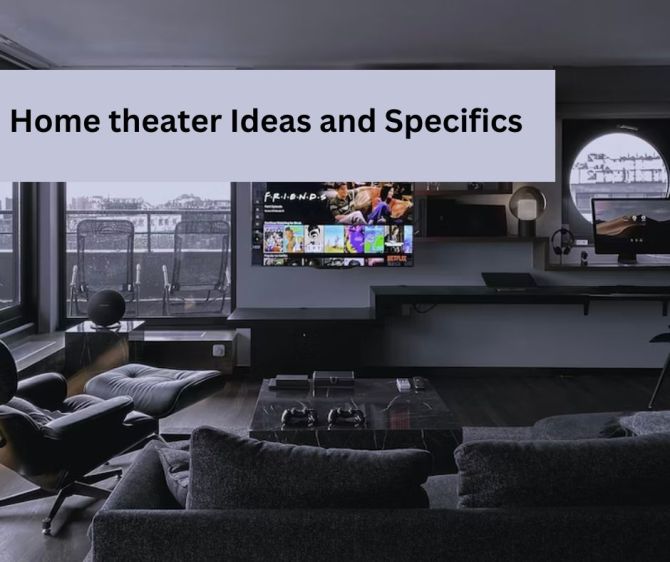
Home movie theater ideas
Want to bring the movies to your house? Let’s discuss home theater examples, and try to understand how you can have one and what is necessary for it!
An innovative project that delivers the entire movie experience to your front door is converting your living area into a home theater. A home theater offers the ideal environment for enjoying your preferred entertainment in the comfort of your own home, whether you're a movie enthusiast or an obsessive gamer. We will cover all you need to know to build a cutting-edge home theater in this extensive tutorial.
Let's dive into the realm of home theaters and learn how to turn your ideal entertainment area into a reality, from budgetary considerations to room dimensions and equipment components.
How do you make a home theater at home?
Planning carefully and taking into account many elements are required while designing a home theater. Pick an appropriate space in your house to start with, ideally a basement or spare room with little to no outside noise and natural light. Choose the layout, seating arrangement, and acoustics after that.
To recreate the movie experience, think about spending money on premium speakers, a projector or big-screen TV, and comfy seating.
Furthermore, soundproofing and illumination controls can improve immersion even more. To gain the greatest performance, connect your equipment and calibrate the audio and video settings.
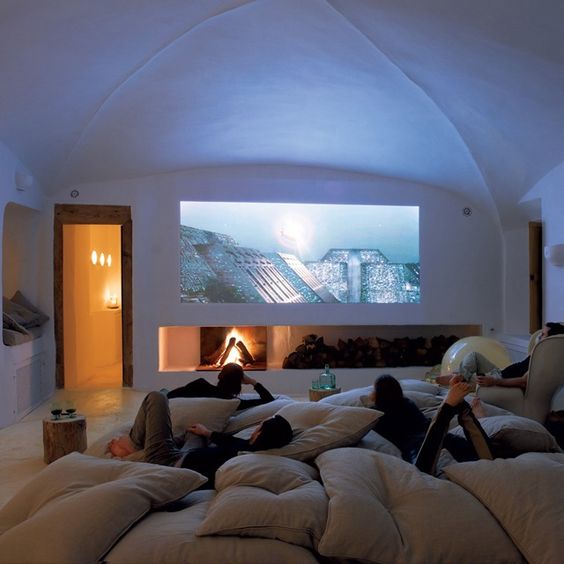
Photo credit: pinterest.com
Home theater cost examples
Building a home theater can be very expensive, depending on your choices and budget. A basic home theater setup that comprises a large-screen TV, a soundbar or a straightforward surround sound system, and comfortable seats can cost anywhere between $1,500 and $3,000.
However, the price range for a mid-range setup with a projector, screen, surround sound system, and comfy seats is between $5,000 and $15,000.
If you want the greatest home theater experience with top-notch equipment, individualized seats, and acoustic treatments, the cost may exceed $20,000 or more. You must prioritize your needs and establish a budget in order to strike the perfect balance between cost and quality.
Here is an approximate cost calculation of a budget-friendly home theatre.
|
Component |
Approximate Cost |
|---|---|
|
TV or Projector |
$500 - $5,000+ |
|
Screen |
$100 - $500+ |
|
Audio Receiver |
$200 - $1,000+ |
|
Speakers |
$300 - $2,000+ |
|
Subwoofer |
$100 - $500+ |
|
Media Player |
$50 - $300+ |
|
Seating |
$500 - $2,000+ |
|
Lighting |
$50 - $500+ |
|
Soundproofing |
$100 - $500+ |
|
Installation Cost |
$500 - $2,000+ |
What's included in a home theater installation
Several important components are often included in home theater installation. The audio system, which consists of speakers, a subwoofer, and an audio receiver or amplifier, is the first component. A large-screen TV or projector, along with a projection screen, make up the video system. Source components like a Blu-ray player, game console, streaming device, or media server are also required. For connecting all the components and guaranteeing optimal operation, wiring, and cables are essential.
Additionally, room acoustics are important, and soundproofing materials and techniques improve the audio quality. To get the most out of your home entertainment system, professional installation services may help with the wiring, calibration, and proper positioning of your equipment.
To create an immersive home theater experience, it's important to understand the various components that make up a home theater system. Let's explore the key elements of a home theater setup:
1. Display Device:
The display device is the centerpiece of your home theater system. You have two main options: a large-screen TV or a projector and screen combination. High-definition televisions (HDTVs) offer crisp visuals and vibrant colors, while projectors can create a theater-like atmosphere on a larger scale.
2. Audio System:
The audio system is a vital component of a home theater, as it enhances the immersive experience. There are several options to consider:
a. Speakers: A surround sound speaker system is commonly used in home theaters. It typically consists of front speakers (left, center, right), rear speakers (left surround, right surround), and a subwoofer for low-frequency effects.
The number and type of speakers can vary depending on your budget and desired audio quality.
b. Soundbar: A soundbar is a single unit that houses multiple speakers in a compact design. It offers an easy setup and can provide a virtual surround sound experience, although not as immersive as a full speaker setup.
c. Audio Receiver: An audio receiver acts as the hub of your audio system, connecting all the speakers and sources. It decodes audio signals and distributes them to the appropriate speakers, amplifying the sound as needed. Ensure the receiver supports the audio formats you plan to use, such as Dolby Digital or DTS.
3. Source Components:
Source components provide the content for your home theater system. Some common options include
a. Blu-ray or DVD Player: These devices allow you to play high-definition Blu-ray discs or DVDs, providing access to movies and other video content.
b. Media Streaming Devices: Streaming devices like Apple TV, Roku, or Chromecast enable you to stream content from popular services like Netflix, Amazon Prime Video, or Hulu.
c. Gaming Consoles: If you're a gamer, a gaming console such as PlayStation or Xbox can be connected to your home theater system to enjoy gaming on the big screen.
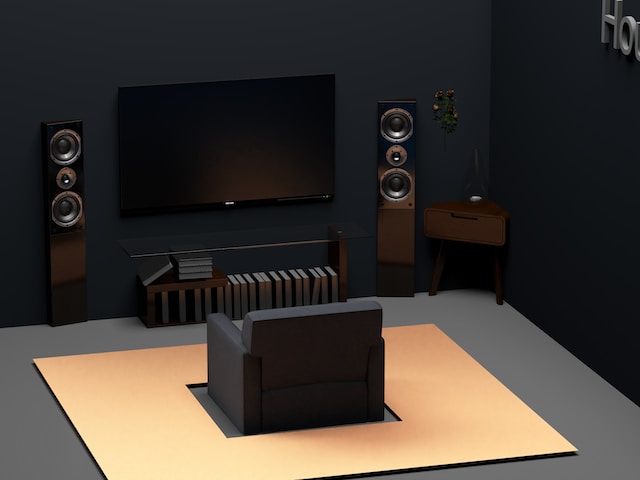
Photo by MING on Unsplash
4. Control Devices:
Control devices make it easier to manage your home theater system. These can include:
a. Universal Remote: A universal remote consolidates control of various devices into one remote, simplifying the operation of your system.
b. Mobile Apps: Many home theater systems have accompanying mobile apps that allow you to control and configure the system using your smartphone or tablet.
5. Cables and Wiring:
Cables and wiring are essential for connecting all the components of your home theater system. HDMI cables are commonly used to transmit both audio and video signals. Ensure that the cables are of high quality to maintain signal integrity and minimize any signal degradation.
6. Furniture and Seating:
Comfortable seating and furniture enhance the viewing experience in your home theater. Consider options like reclining chairs, sectional sofas, or dedicated theater seating to recreate the theater ambiance.
7. Room Acoustics:
Room acoustics play a crucial role in achieving optimal sound quality. Acoustic treatments, such as sound-absorbing panels, bass traps, and diffusers, can improve the acoustics of your home theater room by reducing echo and unwanted reflections.
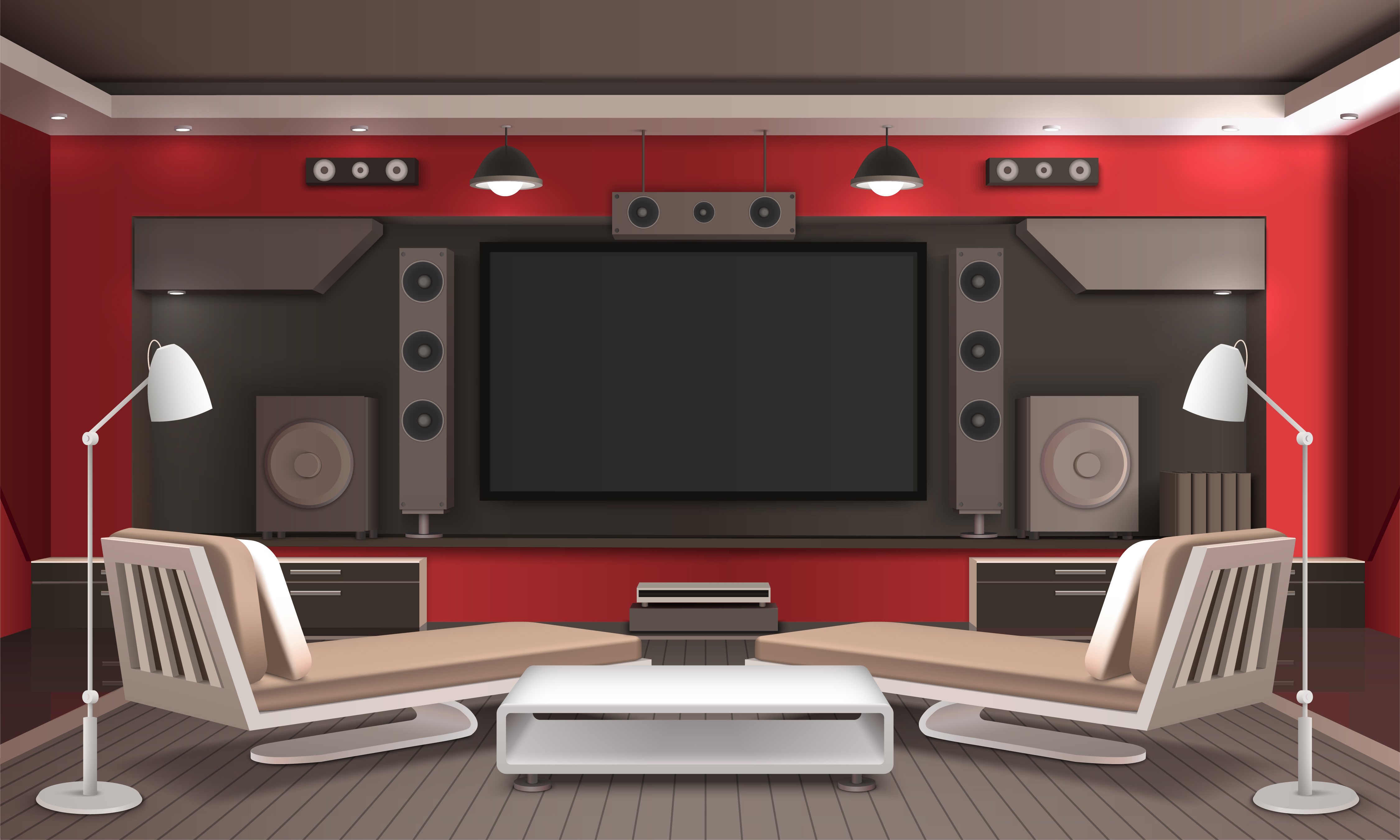
Image by macrovector on Freepik
Does a Theater Room Add Resell Value?
A home cinema room may be able to increase a property's value, but how much will depend on a number of different circumstances.
Market Demand: The present market demand plays a significant role in determining how desirable a home theater room is. A dedicated home theater room might be considered as a useful addition that distinguishes the property from others if a sizable portion of buyers in the market value entertainment and luxurious amenities.
Location and Price Range: Depending on the property's location and price range, the impact on value may differ. A well-designed and fully-equipped home cinema room can have a stronger beneficial impact on the house value in higher-end luxury markets where purchasers anticipate premium amenities.
Quality and Design: The home theater room's quality and design are also important factors in assessing its value-added potential. In comparison to a less spectacular or badly executed setting, a professionally constructed space with high-quality audio-visual equipment, comfortable seating, and good acoustics is more likely to attract buyers and add value.
Versatility and Flexibility: The space's adaptability and flexibility are another factor to take into account. A home theater room that is readily transformed into a multi-purpose space, such a media room or an additional living area, may appeal to a wider audience and raise the value of the home.
It's crucial to keep in mind that while a home theater room can increase a property's appeal and marketability overall, buyer preferences can change. While some purchasers could consider it to be a significant feature, others might not place the same value on it.
The effect on a home's worth will ultimately be determined by the particular conditions and preferences of potential buyers in the market.

Photo by Pawel Czerwinski on Unsplash
Paint Color Ideas for Home Theatre
There are certain things to think about when selecting paint colors for a home theater. Here are a few ideas:
Dark and Rich Colors: Use dark and rich colors to evoke the mood of a movie theater and improve the viewing experience. Deep hues of navy blue, gray, or burgundy can produce a warm and inviting atmosphere.
Choose matte paint finishes to reduce reflections and glare from the projector or screen for greater image quality and a more enjoyable viewing experience.
Accent Wall: Take into account building an accent wall behind the TV or other viewing location. To draw attention to the screen and provide visual interest, paint this wall a darker shade or a different hue from the nearby walls.
Neutral or Dark Ceilings: A ceiling that is neutral or dark can absorb light and minimize distractions. Ceilings that are black or dark gray are frequently employed to give rooms a sense of depth and make them feel more enclosed.
Utilize light-blocking strategies to ensure minimal light interference and preserve the theater-like ambiance, such as blackout curtains, shades, or light-absorbing panels.
Wall coverings: Take into account employing sound-absorbing panels or specialist acoustic wall coverings made for home theaters. These can improve sound quality and give the walls a pleasing texture or pattern.
Considerations for Lighting: Pay attention to the lighting in the space. To create a soft, indirect glow that won't obstruct the screen, use dimmable recessed or wall sconce lighting. For a discreet and adaptable atmosphere, think about putting LED strip lighting below seating platforms or along baseboards.
Keep in mind that your color selections may be influenced by your own preferences as well as the specific style of your home theater. Before making a decision, it's a good idea to test out paint samples on a small section of the walls and see how they seem in your theater room's lighting.
What is the average size of a home theater room?
Home theater room size is determined by a number of elements, such as available space and individual preferences. A dedicated home theater room should, as a rule, be at least 12 feet by 16 feet in size. This enables adequate seating, appropriate equipment placement, and ideal screen viewing distance.
However, with portable technology and smart design decisions, smaller spaces can nonetheless be converted into efficient home theaters. To get the finest viewing and listening experience possible, it's important to take into account the size and positioning of the seats, screen, and audio components.
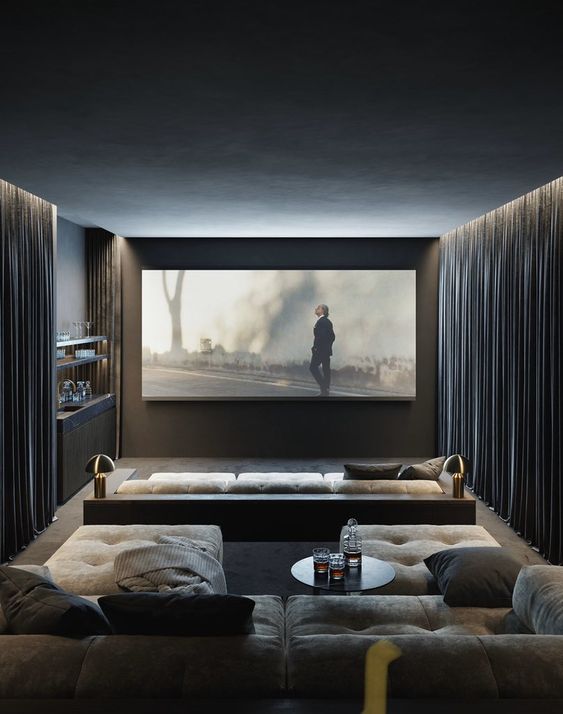
Photo credit: pinterest.com
What color should the ceiling be in a theater room?
It is advised to choose a dark color, such as black or a rich shade of gray, for the ceiling in a home theater room. A dark ceiling aids in absorbing extra light and minimizes reflections that can deteriorate the screen's image quality. Additionally, it adds depth and improves the atmosphere of the movie.
All of the components of a home theater system must be carefully considered. You may create a cinematic experience in the comfort of your own home by picking the appropriate display, audio system, source components, control devices, and seating arrangements. Whether you want a straightforward configuration or a high-end one, spending money on high-quality parts and thoughtful design will ensure that your home theater becomes the ultimate entertainment hub for enjoying movies, TV shows, gaming, and more.
FAQ:
How do you make a home theater at home?
Planning carefully and taking into account many elements are required while designing a home theater. Pick an appropriate space in your house to start with, ideally a basement or spare room with little to no outside noise and natural light. Choose the layout, seating arrangement, and acoustics after that.
To recreate the movie experience, think about spending money on premium speakers, a projector or big-screen TV, and comfy seating.
Soundproofing and illumination controls can improve immersion even more. To gain the greatest performance, connect your equipment and calibrate the audio and video settings.
Quick Tips:
-
Choose a room with optimal dimensions and minimal light
-
Invest in a projector or large TV screen
-
Purchase comfortable seating and install dimmable lighting
What should be in a home theater?
-
A large TV screen or projector
-
Comfortable seating
-
High-quality surround sound system
-
Acoustic treatment
-
Dimmable lighting
How to turn your living room into a theater?
-
Choose a room with optimal dimensions and minimal light
-
Install a large TV screen or projector
-
Purchase comfortable seating and install dimmable lighting
-
Install quality speakers and acoustic treatment
Does a theater room add value?
Yes, a theater room can add value to a home, especially for those who love entertainment and the cinema experience.
How much should I budget for a home theater?
The budget for a home theater varies depending on the quality of components, room size, and personal preferences. It can range from a few thousand dollars to tens of thousands.
What is the ideal surround sound setup?
The ideal surround sound setup includes a 5.1 or 7.1 speaker configuration, with a center channel, front left and right, surround left and right, and a subwoofer. It provides an immersive audio experience.


